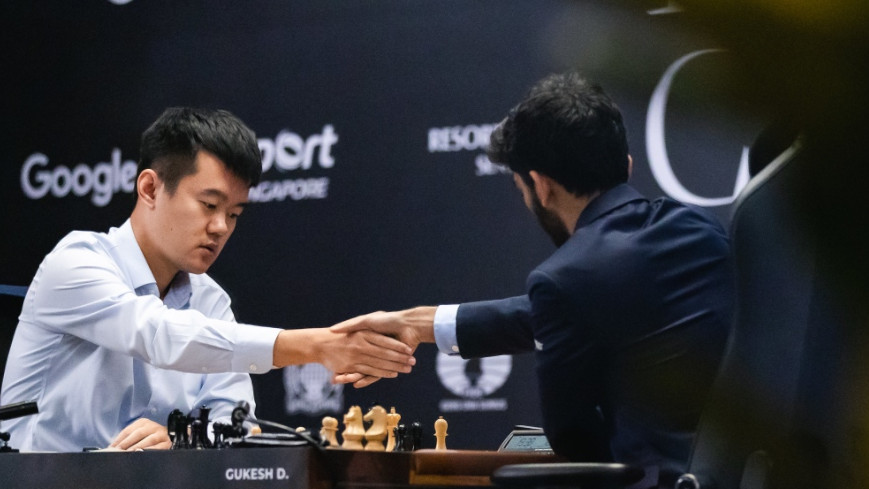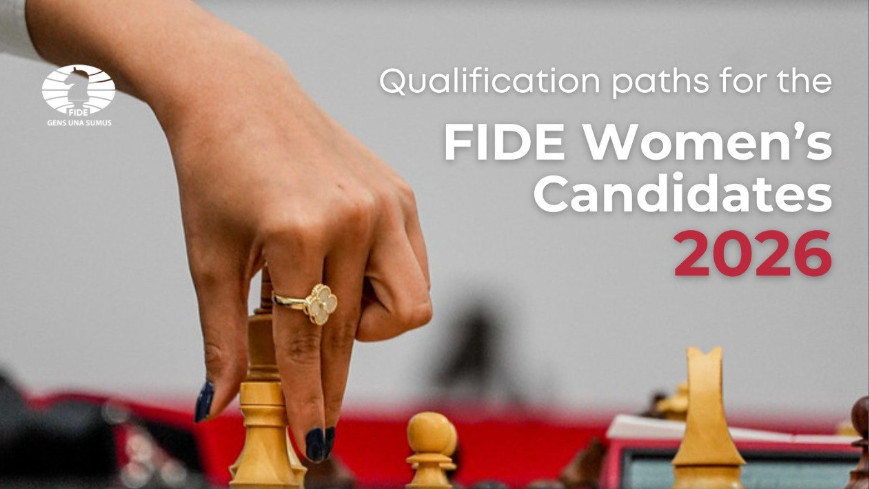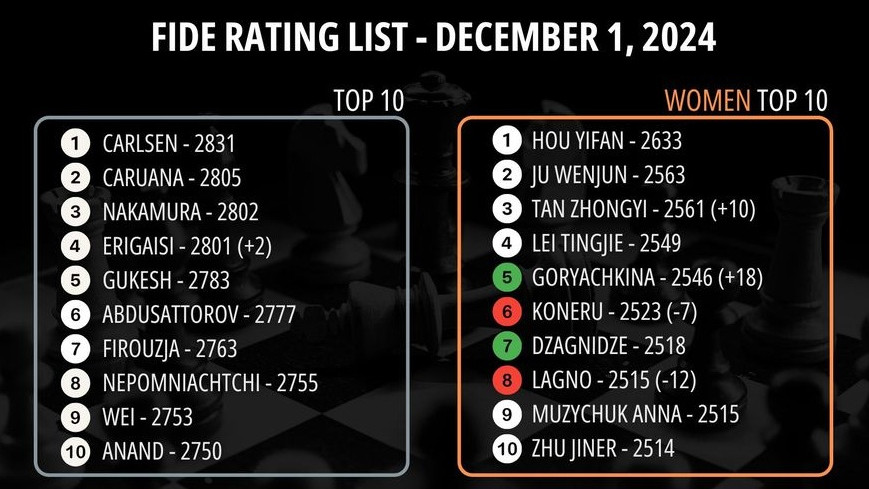FIDE World Championship Game 11: Ding collapses under pressure as Gukesh takes the lead

This afternoon in Singapore, the 18-year-old chess prodigy Gukesh D took a huge step toward becoming the youngest classical chess champion in history. After one of the most exciting games of the match, in which both players spent almost an hour on one single move, he defeated the champion Ding Liren, setting the match score at 6-5 with only three games to go. Let’s take a closer look at today’s game. A double ceremonial move inaugurated the eleventh game, made by two chess trailblazers. GM Hou Yifan, 4-time Women’s World Champion, made the ceremonial first move today for Ding Liren. Hou Yifan has achieved many notable accomplishments: At 14 years, 6 months, and 2 days old, she became the youngest female player to ever earn the grandmaster title. At 16, Hou became the youngest ever to win the Women’s World Chess Championship. She is the second highest rated female player of all time, and one of only three women to have been rated among the world’s top 100 players. GM Eugene Torre from the Philippines, made the ceremonial first move for Gukesh D. Torre has been a trailblazer for Asian chess for half a century, achieving a number of continental milestones including first grandmaster, first to defeat a reigning world champion, and first to reach the Candidates stage of the World Championship. A member of the Philippine Olympiad team a record 23 times, Torre won three individual medals on board one. He also won a bronze medal on board three at Baku 2016 at the age of 64. Playing with White, Gukesh went for the reversed Blumenfeld gambit for the first time in his life, sacrificing a pawn for the initiative! “A provocative opening, not necessarily computer approved, but this is a human game,” explained GM David Howell in the commentary booth. The database revealed only one game played by Ding Liren in this opening (an online rapid against Indian GM Adhiban Baskaran). However, interestingly enough another very strong Indian player, GM Arjun Erigaisi, has had a lot of success with this gambit, and it has been rumored that Erigaisi may be one of Gukesh’s “secret” seconds in this match… Ding Liren went into the tank for nearly forty minutes (!) to decide on his opening approach – to accept the pawn gambit with 4…dxe3, or play 4.Nf6 and potentially running into Gukesh’s preparation. “It was a very difficult game for me. Already on move four, I wasn’t sure if I had made the correct choice. I remembered a game I played in a rapid tournament against GM Adhiban, but I couldn’t remember the other moves. I spent 40 minutes calculating some nonsense variations,” a visibly upset Ding explained after the game. “I do wonder if it’s this conscience thing – you take a quick draw with White and in your mind, you feel guilty, you don’t feel good about yourself afterward. Every time I take a quick draw with White, just like Ding did yesterday, I guarantee I will lose the next game with Black. It’s happened many times in my career,” added GM David Howell in the commentary booth. The official novelty of the game was 5…Bg4. By this time, Ding had already used up more than an hour – half of his total thinking time. “These types of positions with …c5 and …d4 can be very tricky, for both sides,” explained four-time Women’s World champion Hou Yifan, who joined the commentary at the end of the opening. “Sometimes the lack of time is a factor, but other times the position is more important. Players need to balance well their time-management. But today, there is already a huge time difference.” On move nine, Gukesh could have played 9.c5 and develop his light-squared bishop actively to c4 or b5. Instead, he preferred to close down the queenside and then spent an hour of his thinking time to calculate all the complications in the line 11.g3 and 12.Bg2, which allowed Ding’s knights to create some threats in the center. Hou Yifan offered a bit more insight on Ding Liren: “I played many games against Ding when we were younger. He is a very creative player and can play all the structures. He doesn’t always play the most logical moves, but he often is more thoughtful.” At this point, Gukesh thought that he had messed up the opening, but he saw come chances to get back into the game in the middlegame: “Full congratulations to my team for their effort in the preparation of this opening, which caught my opponent by surprise. Then I did some stupid things, but I am happy I was able to get it back together,” he shared. Ding was getting into time trouble and Gukesh took advantage by sacrificing the b-pawn and then pressing with all his pieces on the queenside, along the b-file and the h1-a8 long diagonal. Ding was hanging on but everyone in the media center sensed that he might crack at any moment. In the end, time pressure proved decisive. With only seven minutes to go, Ding blundered on move 28, dropping a piece in a one-move combination. Instead of 28…Nb4, returning his extra pawn with decent drawing chances, he played the losing 28…Qc8 and after 29.Qxc6 had to resign. In an attempt to remain positive, Ding Liren recalled that in the previous match he managed to make a come-back: “In the last match I made a comeback on the twelfth game, so I am hoping to play well tomorrow.” After eleven of the fourteen scheduled classical games, Gukesh D. leads 6-5. The twelfth game will take place on Monday, December 9th at 5 PM local time in Singapore, with Ding Liren playing White. FACT SHEET, Game 11, FIDE World Championship: White: Gukesh D.Black: Ding LirenResult: 1-0Game length: 29 movesOpening: Reti OpeningVariation: Reversed Blumenfeld GambitMatch score: 6-5 (for Gukesh D.) Although the FIDE World Championship takes central stage, the local organizers along with FIDE have arranged a wide range of side
Argentine Championship: Sandro Mareco claims second title

GM Sandro Mareco has been crowned champion of the 99th Argentine Championship. The 12-player round-robin tournament, with classical time control, took place from November 26 to December 6, 2024, at City House in Buenos Aires. The championship evolved into an exciting duel between top-seed Mareco and defending champion GM Fernando Peralta. IM Lukas Coro shared the lead until Round 7, but consecutive losses to both Mareco and Peralta knocked him out of contention for the podium. Entering the final 11th round a half-point ahead of his closest rival, Sandro Mareco secured his second national title by defeating IM Pablo Ismael Acosta and finishing with an impressive score of 8.5/11. Sandro previously won this event in 2015. Peralta also won his final-round game, beating Faustino Oro, and claimed second place with a strong score of 8/11. IM Diego Flores completed the podium in third place. Remarkably, all three top finishers went undefeated throughout the event. A standout performance came from 11-year-old prodigy Faustino Oro (pictured below, right), making his debut in the super-final. Oro delivered a solid showing, scoring 6.5/11 and finishing in fourth place. Final standings: 1 GM Mareco, Sandro 2580 8½ 2 GM Peralta, Fernando 2546 8 3 GM Flores, Diego 2552 7 4 IM Oro, Faustino 2433 6½ 5 IM Coro, Lucas 2401 6 6 GM Perez Ponsa, Federico 2536 6 7 GM Krysa, Leandro 2496 5½ 8 FM Spata, German 2399 4½ 9 NM Asprelli, Gaspar 2245 4 10 IM Acosta, Pablo Ismael 2454 4 11 GM Valerga, Diego 2445 4 12 FM Tokman, Ariel 2390 2 Photos: Federación Argentina de Ajedrez (FADA)
FIDE World Championship Game 10: Ding hits a brick wall as match stands at 5-5

As the players approach the final stages of the match, we are witnessing increasingly cautious play. Neither opponent is willing to risk making a mistake that could undermine the efforts they have invested so far. First to arrive at the venue this afternoon, exactly ten minutes before the start of the round, was the champion Ding Liren. Accompanied by his two main coaches, GM’s Ricard Rapport and Ni Hua, Ding underwent the anti-cheating body checks and then spent a few minutes meditating in the sunshine on a special chair outside the playing hall. A few minutes later, the challenger Gukesh D, with his father and his main coach GM Grzegorz Gajewski, exited the lift and quickly joined his opponent at the board, ready for the game. The master of ceremonies, GM Maurice Ashley, introduced the players and was joined by Mr Kon Yin Tong, Chair at Sport Singapore, for the ceremonial first move. Kon Yin Tong served as a Sport Singapore council member from 2012 before becoming Deputy Chairman in 2016 and subsequently Chairman in October 2018. He has held roles with Sport Singapore as Finance Committee Chairman, and leads the Sports Excellence Scholarship selection and approval committee. Perhaps a slight moment of doubt right at the beginning of the game, Ding Liren paused momentarily when executing his first move (1.d2-d4), which caught commentators’ attention. When asked about it after the game Ding explained with a grin: “I realized it was the same if I started with 1.Nf3 as he can also play 1…d5 like the previous games and I can transpose with 2.d4.” Playing with White, the champion once again went for the London system, repeating the line he used in game six. This time, he tried out a relatively unconventional idea: 5.Be2, followed by 6.dxc5 and 7.c4 – a setup previously used by his second, GM Richard Rapport. “This opening is one of my second’s ideas – apart from this line, I had also prepared for the other line,” Ding revealed after the game. “Pawn to Ding Four,” was commentator GM David Howell’s reaction to the champion’s opening. “This is the third time in the history of the World Championship Matches that we have seen the London System, and all three of them have been played by Ding.” A few moves later, the pawn structure resembled one of the many lines of the Queen’s Gambit Accepted, but with White’s c1-bishop developed outside the pawn chain. A quick scan of the database revealed a couple of games played by Ding’s second GM Richard Rapport in this same line, against GM’s Aronian and Shankland in 2018-2019. “Black’s position is very solid; it has no weaknesses. White has a very small dynamical advantage, slightly better development. He has to take advantage of this momentum to develop some initiative,” said GM Pavel Eljanov, former coach of many top players such as Boris Gelfand and Anna Muzychuk. However, Ding Liren didn’t seem in the mood to play an attacking game. He quickly found an opportunity to exchange queens and a couple of minor pieces, inflicting a very small pawn weakness on his opponent’s kingside – it definitely didn’t seem enough to press for a win. “I thought I had a stable advantage but after 11…Be7 it’s not the case. My bishop is very bad,” Ding admitted. “Ding is looking for a small but absolutely risk-free advantage. Keeping the queens on the board was much more ambitious,” Eljanov added. “It’s like going into one of those Norwegian homes with barely any furniture, it’s just minimalism,” joked Howell with Jovanka. But with no real chance for a favorable outcome, Ding exchanged queens and liquidated to a totally equal ending. The game ended in a draw by a threefold repetition on move thirty-six. “Obviously, I am up for a game with either color, but to get a solid draw like this with Black is obviously a good result,” said Gukesh after the game. After ten of the fourteen scheduled classical games, the match remains tied at 5-5. The eleventh game will take place on Sunday, December 8th at 5 PM local time in Singapore, with Gukesh playing White. FACT SHEET, Game 10, FIDE World Championship: White: Ding LirenBlack: Gukesh DResult: 0.5-0.5Game length: 36 movesOpening: London SystemMatch score: 5-5 Although the FIDE World Championship takes central stage, the local organizers along with FIDE have arranged a wide range of side events for all the fans coming to Sentosa for the match. On the agenda this afternoon, GM’s Alexandra Kosteniuk and Anna Muzychuk played a 20-board tandem simultaneous exhibition for VIP ticket holders, achieving 18 wins and 2 draws. Additionally, GM Pavel Eljanov joined the official commentary and gave his thoughts on the game in progress, and then joined GM Maurice Ashley in the fan-zone, providing entertainment for the onsite spectators. Written by IM Michael Rahal (Singapore) Photos: Eng Chin An, Maria Emelianova and Singapore Open Official website: worldchampionship.fide.com/ Full programme of side-events: worldchampionship.fide.com/events About the event Current World Champion Ding Liren, representing China, and challenger Gukesh D, from India, face each other in a fourteen-game classical chess match. The player who scores 7.5 points or more will win the match, picking up the better part of the $2.5 million total prize fund. The first of the fourteen scheduled games took place on Monday, November 25 at 5 pm with Gukesh opening with White. Hosted at the luxurious Resorts World Sentosa the match is broadcast live with expert commentary on the FIDE YouTube Channel.
FIDE Council approves extension of FIDE Flag Representation

FIDE Council has approved the extension of FIDE Flag Representation for Russian and Belorussian players. According to this decision, Russian and Belorussian players currently performing under the FIDE flag are permitted to continue playing under the FIDE Flag until January 1, 2026. For more information, please refer to the FIDE Council resolution of September 20, 2023.
FIDE World Championship Game 9: The calm after the storm

In common wisdom, after a violent storm, the weather typically becomes calm. After a period of turmoil or chaos, peace and tranquility follow. In the wake of the two very complex and dramatic previous games, today’s encounter was quite a peaceful affair. After Dr Shilpak Ambule, High Commissioner of India to Singapore performed the ceremonial move for Gukesh this afternoon, the Indian challenger opened the game with 1.d4. Playing with Black, Ding Liren opted for the Bogo-Indian defence, which after a few moves transposed into one of the most popular lines of the Catalan Opening. Although both players have employed the Catalan regularly in the past, it was the first game of the match featuring this opening. The first key moment came when Gukesh essayed an interesting move 10.Bc3 (see diagram below). One of the ideas was to try and get in b2-b4 straight away. In this position, there are hundreds of games played with the more popular 10.b3 and above all 10.Bf4. Visibly surprised, Ding Liren spent nearly twenty minutes pondering on his response, finally choosing the standard development with 10…Bb7. Still in preparation, Gukesh expanded on the queenside with 13.b4 and soon after started working his way into his opponent’s position with the dangerous pin 16.Ba5. The Indian was playing fast and confidently, while Ding appeared to overthink his moves. On move seventeen, the engines suggested a forced line beginning with 17…Nxc4, with massive exchanges. Instead, Ding preferred to relinquish his bishop with 17…Bxf3 and defend a slightly worse middlegame. Reflecting after the game, Ding admitted missing this good opportunity to equalize: “My second told me after the game that I could have played 17…Nxc4 equalizing easily. I calculated the line but missed 19…Nd7 and I am not worse at all.” By move 20, Gukesh held a significant time advantage with one hour twenty-one minutes, while Ding Liren was down to thirty minutes! Put yourself in Gukesh’s shoes. Would you play 20.Qb5 or maybe 20.Ne5? “The game was very precise. I might have had a small edge after 16.Ba5, but I think that 20.Qb5 was premature: maybe I should have played 20.Ne5 with a small edge, although it shouldn’t be decisive in any way,” explained Gukesh after the game. “It was based on a miscalculation: I missed his defensive idea 21…Qa7 and 22….Rb8.” From then on, the champion played very accurately, successfully neutralizing White’s initiative and liquidating to an equal ending, in which he even had a tiny edge. In the press conference, Gukesh calmly analyzed the match situation: “So far, it’s been a very interesting match: a few missed chances from me, a few missed chances from him. We have both showed fighting spirit and entertaining chess, and there are still five more exciting games to go.” He added: “Especially in the last few games, I think I’m playing pretty well, and I just hope to continue playing good games, and hopefully, at some point when I do the right things, I believe that the results will come.” FACT SHEET, Game 9, FIDE World Championship:White: Gukesh D Black: Ding LirenResult: 0.5-0.5Game length: 54 movesOpening: Catalan Opening (stemming from the Bogo-Indian Defence)Match score: 4.5-4.5 Although the FIDE World Championship is by far the main event, the local organisers along with FIDE have arranged a wide range of side events for all the fans coming to Sentosa for the match. Today’s agenda featured a variety of activities, starting with a lecture in the Fan Zone by FIDE Vice President GM Zurab Azmaiparashvili, who shared insights into his experiences as a second for Garry Kasparov. In the afternoon, FIDE CEO Emil Sutovsky participated in the Chess History Trivia Quiz, while Singapore’s own stars, GMs Tin Jingyao and Siddharth Jagadeesh, entertained spectators with live interactions in the fan zone. The Singapore International Open also concluded this morning, bringing together 559 players from 34 federations, including 37 GMs and 6 WGMs. GM Lu Shanglei from China emerged as the clear winner, while GM Szymon Gumularz from Poland clinched silver and local GM Jagadeesh Siddharth secured bronze. Written by IM Michael Rahal (Singapore) Photos: Eng Chin An, Maria Emelianova and Singapore Open Official website: worldchampionship.fide.com/ Full programme of side-events: worldchampionship.fide.com/events About the event Current World Champion Ding Liren, representing China, and challenger Gukesh D, from India, face each other in a fourteen-game classical chess match. The player who scores 7.5 points or more will win the match, picking up the better part of the $2.5 million total prize fund. The first of the fourteen scheduled games took place on Monday, November 25 at 5 pm with Gukesh opening with White. Hosted at the luxurious Resorts World Sentosa the match is broadcast live with expert commentary on the FIDE YouTube Channel.
World Championship Game 8: Thrilling battle ends in a draw

The eighth game of the 2024 FIDE World Championship, presented by Google, will go down in history as one of the most exciting encounters ever played in title matches. It was a struggle all the way through, with chances for both players, which finally ended in a draw after the challenger once again rejected a draw by threefold repetition. The game began with the traditional ceremonial move, played by two distinguished guests. Opening 1.b3 with White, Mr. Kingston Kwek is a cryptocurrency entrepreneur and the founder of Academic Labs, or “AAX,” a sponsor of the chess championships. An avid chess player himself, Kwek enjoys playing against chess engines and on online platforms. Grandmaster Kevin Goh Wei Ming, an eight-time Singapore National Champion, has represented his country in eight World Chess Olympiads and three South-East Asian Games. He is a Chartered Accountant and was the CFO of one of the fasting growing biomedical start-ups from Singapore before joining the Singapore Chess Federation as its CEO. He is also the chair of the Local Organizing Committee. On his move with Black, Kevin decided to counter with 1…a5, a move which elicited a smile from Ding Liren. The champion Ding Liren opened the game with 1.c4, the English Opening. Following the trend shown so far by both players, Ding Liren decided not to repeat any of the opening moves used previously – we had a fresh position on the board! “I have been playing the English Opening for the last ten years and one of the downsides in the variations in which Black plays a quick …e5 is that there are so many options,” observed GM David Howell in the commentary booth. He added, “When I am preparing a game, I often find that I am going down these rabbit holes, twenty moves deep in some variations, and then my opponent surprises me on move two or three. Suddenly you find yourself in waters that you haven’t researched recently.” The challenger Gukesh D replied almost instantly and essentially blitzed out his first ten moves, once again displaying excellent opening knowledge and specific preparation for the match. Ding had the two bishops, Gukesh controlled the center. Gukesh was delighted with his opening choice: “I want to congratulate my team, not only my head coach Gajewski, but also all the other coaches. They are doing an excellent job and I thank them for their interesting ideas,” he said after the game. Meanwhile, Ding Liren seemed to struggle with remembering his own preparation, and soon he was, once again, clearly behind on the clock. After barely thirteen moves, he had already spent nearly half of his thinking time. The position was remarkable – it’s not every day that you see the two center pawns on their original squares. International Master and chess streamer Eric Rosen gave his opinion on the match in the commentary booth: “Coming into the match, I honestly thought it was going to be a blowout in Gukesh’s favor, but now I think we’re in store for another close finish”. The game remained more or less equal for several moves while both players tried to finish their development and find the best squares for their pieces. However, the clock was ticking for the champion, and with less than 15 minutes for 15 moves, he inexplicably went for 25.Bb2, sacrificing his a2-pawn. After the game, Ding explained his reasoning behind the move: “I sacrificed the a2 pawn based on a miscalculation, because I figured that he couldn’t block on c5 with any of the knights, and that would allow me to play Ra1 and pick up the a5 pawn”. “Ding might have overplayed his hand here,” observed David Howell, after Gukesh captured the pawn. The key position of the game arose on move twenty-six. Put yourself in Gukesh’s shoes. Would you play 26…Nac5 or 26…Ndc5? In a very tricky position, Gukesh D. played the natural 26…Nac5, whereas the not-so-logical 26…Ndc5 was the correct move to cement the advantage according to the engines. Reflecting on his decision during the press conference, he admitted: “Blocking with 26…Ndc5 (instead of 26…Nac5) looked weird to me. I thought that my move was winning, but I missed his key move 28.Qe1, when 28…Nxd3 loses to 29.Qc3. If I had spotted this idea, then I would probably have thought a bit more. It was a very tricky position, and he found these ideas very quickly – great defense by my opponent.” Ding immediately blitzed out 27.Rc1 smelling blood. “Ding’s in the zone!” exclaimed GM David Howell. “He’s found the way to trick Gukesh and turn the game around,” observed IM Jovanka Houska, co-host. Forcing his hand, Ding was able to win the exchange, but Gukesh’s two passed pawns were scary. Maybe 31.Ne1 was a better way to go for a win instead of 31.Nd4. Sensing the danger, Ding proposed a draw via a three-fold repetition, but at the last minute Gukesh decided to play on with 41…Qa2+. However, a few moves later, both players recognized the lingering dangers in the position. Ding decided to force the exchange of queens and return the extra material, and a draw was agreed. Ding Liren was visibly happy with the result. “He outplayed me once again, but then he missed some important details and let me back into the game,” the champion acknowledged during the press-conference. In the commentary booth, the local organizer explained the process of getting a top international company to support the event: “Google is very pleased with how the project is going: there are a lot of impressions online and a lot of interest all over the world. It’s all very positive, and hopefully we can continue discussions for more events and collaborations,” said GM Kevin Goh Wei Ming. The ninth game of the match is scheduled for Thursday, December 5, at 5 PM local time in Singapore, with Gukesh playing White. FACT SHEET, Game 8, FIDE World Championship: White: Ding LirenBlack: Gukesh DResult: 0.5-0.5Game length: 51 movesOpening: English OpeningVariation:
World Championship Game 7: Ding Liren escapes by the skin of his teeth

“When you cross the playing hall, you can really feel the tension.” (Anna Muzychuk) The champion Ding Liren dodged a bullet this afternoon. After his huge blunder on move forty, it looked like the challenger was poised to make an important step towards claiming the FIDE World Champion title. Gukesh’s opening strategy was point-on. His team prepared a strong novelty on move seven in a well-known line, allowing him to stay ahead on the clock for most of the game. The champion defended accurately, but at a huge time cost, and with only a few moves to go, he was under acute time pressure. With only seven seconds left on his clock, Ding Liren blundered on the last move before the time control. Instead of 40…Ke5?, he should have played 40…Nc8, followed by 41…Nb6, with a blockade and very good chances to draw. But just when victory seemed locked up for the challenger, nerves kicked in. Converting his endgame advantage was not an easy task, and low on time, Gukesh was unable to find the win. Let’s dive into the details of what actually happened this afternoon in the Sentosa World Resorts Equarius Hotel in Singapore. The ceremonial first move was performed by Mr Edwin Tong, Minister for Culture, Community and Youth, and Second Minister for Law. He chose to open with 1.d4, but after a few seconds, Gukesh took it back and played 1.Nf3 instead, one of his three main opening moves. Ding Liren took a couple of minutes to consider his options and decided on the classical variation of the Neo-Grünfeld defense, with 1…d5 and 2…g6. An expert in this line with White and Black, he had already played this setup on fourteen occasions from 2010 to 2021, against top players such as Nakamura, Kramnik, Svidler and Wesley So. Gukesh blitzed out his opening moves and stunned all the fans with the novelty 7.Re1, a pawn gambit that had never been played before in more than 5000 master games. Ding went into the tank for twenty-five minutes, trying to understand what was going on, and eventually decided to accept the pawn sacrifice, creating an unbalanced position: an extra pawn for Black in exchange for certain positional compensation. “This line is very interesting for me as I play this line with Black regularly. This is the first time I see 7.Re1. It’s a very rare move indeed but with a strong idea behind it, and actually, it’s a bit scary to capture the pawn with 7…dxc4,” explained GM Anna Muzychuk in the commentary booth. A couple of moves later, the champion made a key decision. Instead of protecting his extra pawn with 9…b5 (the suggestion of engines), Ding Liren decided to give it back and also surrender his bishop pair to enjoy a superior pawn structure. “My first mistake was 9…c5 as after 10.d5 my opponent gets a better position and I have a hard defense,” explained Ding after the game. The resulting position seemed slightly better for Gukesh, and additionally he was clearly up on the clock. A few developing moves down the road, the second key position arose. In all of his previous games with White, Gukesh had played g2-g4 at some point. “Now, g3-g4 would be a very Gukesh move,” GM Howell called on commentary. Meanwhile, FIDE media polled the question on X, and included the mirror option b2-b4. Although giving his opponent a protected passed pawn seemed very dangerous, Gukesh bravely pushed his b-pawn on move nineteen. The game was on! White got a pair of bishops and an isolated passed pawn against a well-deployed Black army with a protected passed pawn for the endgame. “I thought I should be winning before the queen exchange and also after the queen exchange,” explained Gukesh in the press conference. “I thought my position after 19.b4 was hopeless,” was Ding’s very frank opinion. Meanwhile, in the commentary booth, GM Anna Muzychuk enjoyed every minute of the event. “Every World Championship match is a wonderful story; it’s unique. No matter how it goes, I enjoy watching every game.” Back on the board, things were getting difficult for the champion. Ding only had 27 minutes left on the clock (Gukesh had 52) for 21 moves in an extremely complicated position, a fact observed by GM Danyyil Dvirnyy on “X”. Additionally, former World Champion Vladimir Kramnik wasn’t impressed at all by the champion’s play, and he made his opinion known on “X”. Taking all of this into account, it’s actually a miracle that he survived to the endgame, as there were many pitfalls along the way. Gukesh could have sealed the deal on several occasions (30.Be3 instead of 30.Qf4, 32.Bg5 instead of 32.Qxf5, and finally 37.Rd2 instead of 37.Rf4) but allowed Ding to stay in the game. Put yourself in Ding Liren’s shoes. Would you play 40…Ke5 centralizing the king or 40…Nc8 to blockade on d6 or b6? With only seven seconds left on the clock to reach move forty, Ding blundered big. Instead of the inferior 40…Ke5?, he should have played 40…Nc8! followed by 41…Nd6, with a blockade and very good chances to draw. After 41.Rh4! Ding lost his h-pawn, and things looked very bleak for Black indeed. But just when victory seemed locked up for the challenger, nerves took their toll. Converting the endgame was not an easy task and, low on time, Gukesh was unable to find the win. Instead of 44.Ke1 played in the game, the correct move was 44.h4 (44.Ra6 also looks quite strong), and the rook ending after 44…Nd2+ is winning for White. “I thought that the endgame with the weak f-pawns and my extra pawn should be enough to win, but it turned out to be more difficult than I expected,” Gukesh explained at the press conference after the game. “For sure, 46.Bd1 was a bad move due to a miscalculation. I don’t know exactly where the win was, but I should be winning,” he lamented. With seven of the fourteen scheduled classical games played,
Qualification paths for FIDE Women’s Candidates Tournament 2026 finalized

A spot that was reserved for the Women’s World Championship runner-up in the previous circle has been reallocated to the broader Women’s Circuit. This decision mirrors a similar change in the Open category. Following the changes in the Open category, the FIDE Council has made amendments to the Women’s World Championship cycle. The runner-up of the Women’s World Championship match no longer automatically qualifies for the Women’s Candidates. Instead, she will receive special bonus points for playing the match. The full list of qualification paths for the Women’s Candidates Tournament 2026 is the following: A. 2 spots – FIDE Women’s Grand Prix Series 2024-25 The players who finish 1st and 2nd in the FIDE Women’s Grand Prix Series 2024-25. B. 3 spots – FIDE Women’s World Cup 2025 The players who finish 1st, 2nd, and 3rd in the FIDE Women’s World Cup 2025. C. 2 spots – FIDE Women’s Grand Swiss 2025 The players who finish 1st and 2nd in the FIDE Women’s Grand Swiss 2025. D. 1 spot – The highest-placed player in ‘FIDE Women’s Events 2025-26’ series Unlike in the open, where a large number of different events is taken into consideration, FIDE Women’s Events 2025-26 will focus only on several major events. Those include: – Rapid and Blitz Championships 2024 and 2025: Including both rapid and blitz formats for two consecutive years; – Women’s Grand Prix Series 2024/2025 edition: Final standings are a significant contributor to qualification; – Women’s World Cup 2025; – Women’s Grand Swiss 2025. Scoring system: Players will be awarded Ranking Points (RP) based on performance in these key events as per a defined table, with players ranked by their best five results. This includes bonus points for the Women’s World Championship runner-up. The final score of a player is calculated as the sum of the player’s RP in up to five of her best events. If players are tied in the final rankings, the tie will be resolved by excluding the lowest RP score used in their final score calculation. Regular updates will be made to the public after each event to reflect the rankings. “The changes aim to streamline and unify qualification pathways by emphasizing top-tier events while providing a fairer distribution of opportunities,” FIDE CEO Emil Sutovsky said. “We believe that these changes will make the competition fairer and more exciting,” he added. The full document is published here:handbook.fide.com/files/handbook/QualificationForWCT2026.pdf
FIDE Circuit 2024: Erigaisi still in the lead, Caruana closes in

The 2024 FIDE Circuit race is approaching its thrilling conclusion. Arjun Erigaisi remains in the lead, but he can’t feel safe as Fabiano Caruana is hard on his heels. With less than a month remaining, the two are separated by just 0.74 points. Erigaisi delivered a solid performance at the Chennai Grand Masters, tying for first place but losing the tiebreaker to Levon Aronian, which left him in third place overall. This result earned him 17.22 points. However, as only the top seven results count toward the final score, Arjun had to forfeit the 5.24 points he had previously earned at the Sharjah Masters. Nodirbek Abdusattorov had high hopes for the 3rd International President Cup, but his fifth-place finish brought him only 9.11 points. As a result, he climbed to second place on the leaderboard but only for a few days. Meanwhile, Fabiano Caruana dominated the competition at the US Masters in Charlotte, NC, securing a clear first-place finish and earning 17.11 points. Unlike Erigaisi, Caruana still has one more tournament result to add to his tally. He will aim to maximize his score at the Saint Louis Masters, a Swiss tournament that begins today. Erigaisi also has a chance to improve his score as he competes in the Qatar Masters in Doha, which has started today. Abdusattorov, currently in third place, will also participate in the event, hoping to regain ground if his main competitors don’t succeed. With all this in play, the 2024 FIDE Circuit race promises an electrifying finish, with Erigaisi and Caruana being the primary contenders for the coveted top spot. We maintain a dedicated page on our website for the FIDE Circuit, offering the latest information on eligible tournaments, the current standings, and regulations.Visit: FIDE Circuit 2024.
Arjun Erigaisi crosses 2800 in December 2024 rating list

The world’s top 10 chess rankings remained largely unchanged in December, but an important milestone was reached. Arjun Erigaisi crossed the 2800 Elo mark, becoming only the 15th player in history to achieve this remarkable feat. The young Indian gained just two points at the 2024 Chennai Grand Masters, but it was enough to join the elite club. Photo: ChessBase India On the women’s side, the winner of WGP Shymkent, Aleksandra Goryachkina, and the runner-up, Tan Zhongyi, gained 18 and 10 points, respectively, with Aleksandra reentering the top five. Biggest gains in Top 100 Open and Women Kochavi, Dana WFM ISR 2362 (+196) Ouellet, Maili-Jade WGM CAN 2386 (+34) Dadha, Daniel GM BEL 2639 (+33) Roebers, Eline IM NED 2373 (+25) Indjic, Aleksandar GM SRB 2647 (+24) Khamdamova, Afruza WIM UZB 2354 (+24) Aleksandra Goryachkina GM FIDE 2546 (+18) Navrotescu, Andreea WGM FRA 2356 (+18) Svane, Frederik GM GER 2668 (+14) Cheparinov, Ivan GM BUL 2646 (+14) WFM Dana Kochavi (pictured below) became the unquestionable winner in this category. Facing very strong opponents in the 2024 European Individual Championship, the Israeli teenager scored an impressive 6.5/11, earning an incredible 186 rating points. This huge increment catapulted Dana into the top 100 women and the top 10 Juniors (women). Photo: Mark Livshitz The European Championship also boosted the ratings of Daniel Dardha, Frederik Svane, Ivan Cheparinov, and the winner, Aleksandar Indjic, who broke into the top 100 Open. Dana Kochavi wasn’t the only youngster to debut in the top 100 Women. Joining her is Afruza Khamdamova of Uzbekistan (pictured below), who dominated the U16 Girls category at the FIDE World Youth Championship (Florianópolis, Brazil) and added 24 rating points to her tally. Photo: Vivian Passig Maili-Jade Ouellet delivered a solid performance in the Fall 2024 Charlotte in the USA to gain 34 points, while Eline Roebers emerged as the winner of the Hoogeveen Schaaktoernooi 2024 double round-robin and increased her rating by 25 points.

